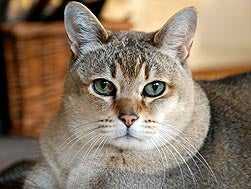Why Do Cats Knead?
By Jennifer Sellers, Petfinder contributor
Cats are mysterious, fascinating animals, and one of the more curious things they do is knead. This beloved activity, which involves the cat pushing her paws in and out against a soft surface, has garnered many euphemisms over the years, such as "making biscuits," but most cat parents are unaware of what the process actually means or achieves (although they can be pretty certain that their cats aren't actually making biscuits-- or any other baked good).

It seems that kneading is a relaxing activity for cats – many will purr contentedly, “zone out” and some may even drool while they do it. But why does it soothe them? And what instinct prompts the action in the first place? Unfortunately, no one knows for certain. There are, however, a few theories:
- Kneading to show contentment or alleviate stress. “Whatever the precise reason for kneading, one thing is for sure: A kneady cat is a happy cat,” says Virginia Wells of PetPlace.com. While we may not know the exact reason cats find kneading pleasurable, everyone seems to agree that it’s something they enjoy – and perhaps the reason cats knead is as simple as that.
- Kneading to create a soft place to sleep. Another hypothesis mentioned on PetMD is that cats' wild ancestors would knead grass to create a soft place to sleep. Cats do, after all, tend to knead before sleeping. (This, by the way, is similar to the theory that dogs turn around in circles before lying down because their wolf ancestors would do so to flatten grass in their resting places.)
- Kneading to generate nourishment Another, possibly more widely held belief, is that kneading is a holdover from infancy – when kittens kneaded against their mother as they suckled. According to Catster.com, “One rather outdated theory proclaims that cats that knead were separated from or weaned from their mother too early, and therefore continue the kittenish behavior into adulthood, yet nearly all adult cats knead, regardless of how or when they weaned.”
- Kneading to mark their territory. Cats have scent glands on their paws and, when a cat kneads, her scent inevitably gets on the surface her paws are working. “Animal behaviorists speculate that an adult cat kneads to show contentment, to calm herself when she's feeling anxious or to mark a person or object with her scent from the sweat glands in her paws,” notes VetStreet.com. So, whether it's a bedspread or your pajama bottoms, your kitty could be leaving a reminder that she was there.
Saving Your Lap from Kitty’s Kneading Claws
As comforting as kneading may be to your cat, it may have quite the opposite effect on you if your kitty kneads with her claws out. Here are a few ways to allow your cat to happily make biscuits without turning your legs into raw dough:
- Keep your cat's claws trimmed (without cutting below the quick).Learn more about how to clip your cat’s nails.
- Train her to move her kneading elsewhere by gently removing her from your lap whenever she gets started.
- Distract her from her kneading by petting her or giving her a toy.
- Allow her on your lap only once you’ve covered yourself with a thick quilt or blanket.
Cat-Kneading Don'ts
There are also things you shouldn't do in response to unwanted kneading. Never punish your cat for kneading by being forceful or loud. Cats do not respond well to negativity. It is also inadvisable to have your cat declawed because of kneading. Declawing is a painful and potentially dangerous process. Learn more about declawing your cat.
Celebrate Your Cat's Feline Mystique
When all is said in done, kneading is a behavior we may never fully understand. But that doesn't mean we can't be enchanted by it and the many other mysterious and endearing behaviors of our feline friends.